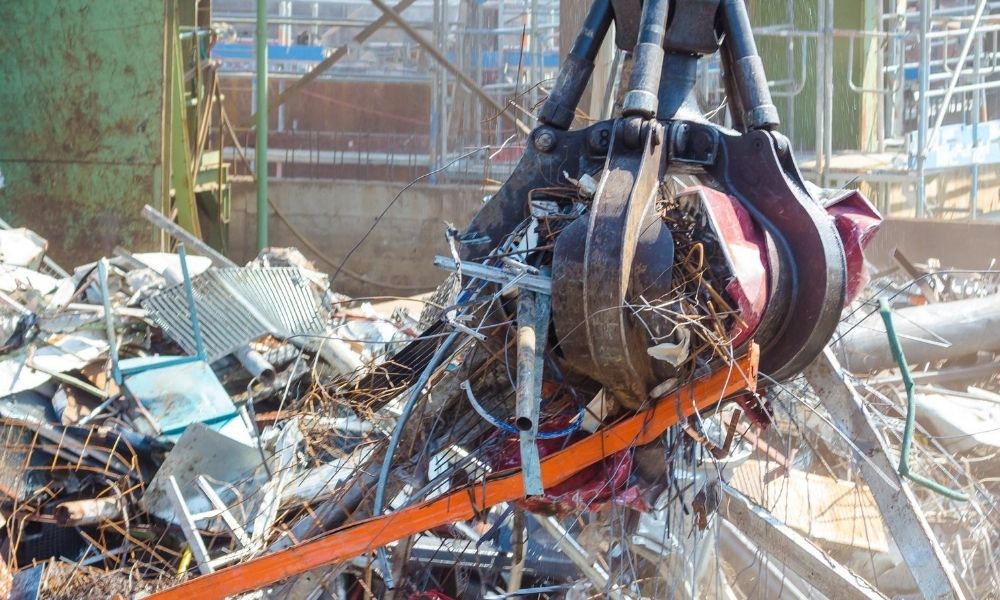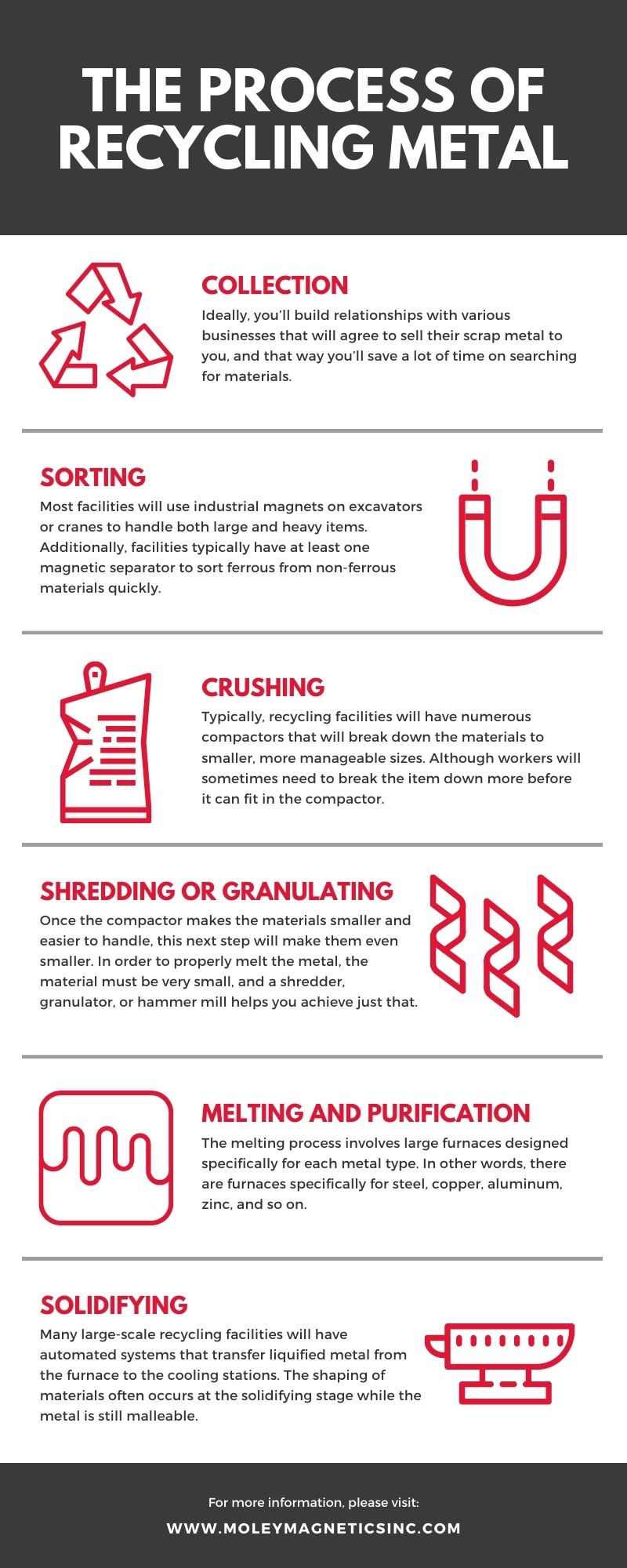
The Process of Recycling Metal
The metal recycling industry is growing rapidly. In fact, projections show that the metal recycling market will grow from 630.0 million tons to 890.7 million tons by 2025. In other words, there’s no question that there’s a growing demand for metal recycling for various reasons. One possible reason is the ever-growing demand for urbanization and manufacturing. Another possibility is that individuals and businesses in recent years have taken eco-friendly operations seriously, and rightfully so.
The process of manufacturing metal from raw materials is not only labor-intensive, but it also puts unnecessary strain on the environment. Manufacturing new metal not only requires a large amount of energy use but also produces large amounts of greenhouse gases. Because of the adverse environmental impact and the substantial cost of producing new metal, more companies seek recycled metal. Whether you’re a recycling plant, a customer, or partner to a metal recycling plant, you must know the process of recycling metal. If you’re interested in learning more, our experts break down the process below.
Collection
As you might suspect, the metal doesn’t necessarily “show up” at your facility; you have to go find it, especially if your recycling facility is relatively unknown. Ideally, you’ll build relationships with various businesses that will agree to sell their scrap metal to you, and that way you’ll save a lot of time on searching for materials. The most common sources of scrap metal are cars, steel structures, ships, railroad tracks, farm equipment, and construction sites. Once the recycling facility collects its materials, it can proceed to the next step.
Sorting
While there are various types of metal, most recycling facilities are only concerned with two types: ferrous and non-ferrous metal, because they’re arguably the most common metal types. Most facilities will use industrial magnets on excavators or cranes to handle both large and heavy items. Additionally, facilities typically have at least one magnetic separator to sort ferrous from non-ferrous materials quickly. There are two main reasons recycling facilities use magnetic separators. The first reason is merely that efficiency is the main factor behind having a profitable metal recycling facility. Although, an equally important reason is contamination. A recycling facility needs to maximize its resources, and you don’t want to mix materials, as mixing can cause contamination and result in an end product that’s less reliable.
Crushing
As we mentioned previously, most of the metal that facilities handle will come in a variety of shapes and sizes. Although some confuse the two, metal recycling facilities aren’t scrap yards. Unfortunately, that reality doesn’t stop individuals and businesses from sending entire vehicles, broken light poles, and various other items to recycling facilities. The point we’re making is that metal recycling involves a fair amount of demolition to make the materials easier to handle. Typically, recycling facilities will have numerous compactors that will break down the materials to smaller, more manageable sizes. Although workers will sometimes need to break the item down more before it can fit in the compactor. Take a light pole, chain, pipes, or pylon for example––all can be various lengths that you may need to cut down with alligator scrap shears before compacting.https://www.moleymagneticsinc.com/product/alligator-shears/
Shredding or granulating
Once the compactor makes the materials smaller and easier to handle, this next step will make them even smaller. In order to properly melt the metal, the material must be very small, and a shredder, granulator, or hammer mill helps you achieve just that. Depending on what material your facility handles, you might only need hammer mills, or you might need each of the previously mentioned machines. By breaking the materials down further, it makes them much more manageable and it requires less energy to complete the recycling process, as well as reducing the possibility of producing excess emissions.
Melting and purification
Arguably the most important step in the metal recycling process is the melting of scrap metal. The melting process involves large furnaces designed specifically for each metal type. In other words, there are furnaces specifically for steel, copper, aluminum, zinc, and so on. Workers should only melt scrap metal in its respective furnace to avoid contamination. While melting requires an energy source, the process of melting metal uses significantly less energy than producing metal from raw materials. In addition to melting the metal, facilities must also ensure the product is pure. There are several purification methods including electrolysis which is probably the most common. Electrolysis is the process of refining a material typically by submerging the metal into a bath of various substances depending on its material. Take copper as an example, as its electrolytic refining process includes submerging the metal into a bath of copper sulfate and several other chemicals. Workers and management should take the purification process seriously as it’s vital to producing high-quality materials.
Solidifying
Of course, what good is metal if it’s not in its solid state? Cooling the metal is the final step, as it solidifies the metal into a working material. Many large-scale recycling facilities will have automated systems that transfer liquified metal from the furnace to the cooling stations. The shaping of materials often occurs at the solidifying stage while the metal is still malleable. Metal recycling facilities typically have special containers that will shape molten metals into various shapes and dimensions. Most facilities ship metal out to manufacturers in sheets, pipes, or bars.
As you might suspect, the final step in the process of recycling metal is the transaction. Depending on the scale of your facility, you might deliver the newly recycled materials to your customers or they might pick the materials up from you. As with any other business, metal recycling facilities face challenges with attaining new and repeat customers. Given the large scale of the metal recycling market, the best customers are other factories or manufacturing facilities that rely on metal for producing their products. Examples of ideal customers could include automotive and home appliance manufacturers because organizational goals often seek recycled materials. By supplying recycled metal, you’re helping companies meet their corporate sustainability goals. In other words, your work makes a difference in corporation operations and, of course, positively affects the environment. The equipment your company uses can make or break your efficiency and overall profitability, so it’s vital to use high-quality equipment.
Whether your facility needs industrial magnets, magnetic separators, shredders, granulators, hammer mills, electric motors, and even services and repairs––Moley Magnetics is for you. We use only the highest-quality materials in all our products because we have the industry experience to know you need reliable equipment. If you’d like to request pricing or have any questions, contact our top-notch customer service team today. We look forward to serving you.


